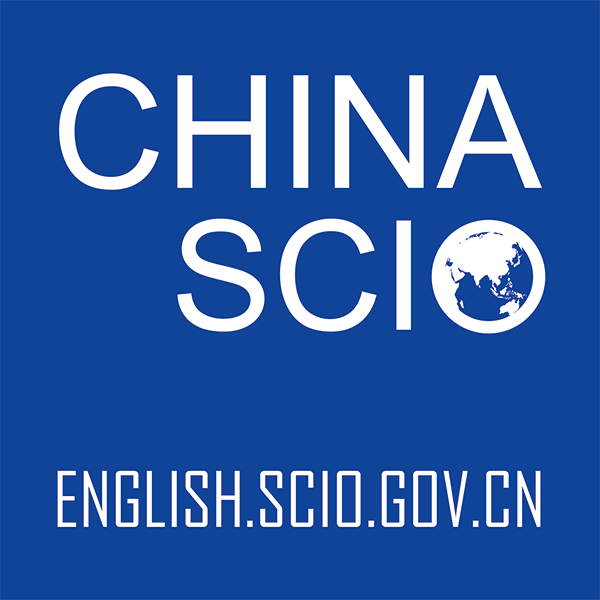


— A research report from the perspective of Xinjiang's population
xju.edu.cn | January 4, 2021
Population is a fundamental, overarching and strategic issue faced by human society. People's understanding of population issues has always been changing with the development of economy and society and the progress of science and technology. Under the initiative of the United Nations, national governments, international organizations and non-governmental organizations have held a large number of international conferences on population issues in order to increase common concern over population issues, realize shared perception of population development and jointly promote population development. At the 1994 International Conference on Population and Development held in Cairo, the United Nations adopted the Programme of Action of the International Conference on Population and Development , clarifying the correlation among population, sustained economic growth and sustainable development. The adoption of the Programme of Action not only indicated an inseparable relationship between population and development, but also means that promoting population development while realizing sustainable development is of great necessity. Therefore, population development not only refers to the changes in number, quality, structure and distribution of population and the development of the irrelations, but also involves the changes in the interaction between population and economy, society, resources and environment.
Since the founding of the People's Republic of China over 70 years ago, the Chinese government has always been adopting a perspective of population in the deployment of economic development strategies, formulation of social development policies and investigation of resource and environmental issues, attaching importance to and adjusting the relationships between population and economy, society, resource, environment and other factors. Xinjiang belongs to China. The population situation in Xinjiang, like that of other parts of China, has always been a priority of the Chinese government. At present, Xinjiang is in a golden period of prosperity and development, with sustained economic development, harmonious and stable society, and people living and working in peace and contentment. However, in order to realize its ulterior political purpose, the United States has repeatedly fabricated lies of China "violating human rights of ethnic minorities" under the pretext of human rights. In the western countries' public opinion campaign against China's Xinjiang, some scholars have conducted a lot of academic activities disregarding the reality in Xinjiang. In June 2020, the German scholar Adrian Zenz published a research report through Jamestown Foundation titled Sterilizations, IUDs, and Mandatory Birth Control: The CCP's Campaign to Suppress Uygur Birthrates in Xinjiang (later referred to as "the report"), which is filled with distorted facts, undetailed information and data of unknown sources. It can be regarded as another attempt to defame Xinjiang from the perspective of population.
I. Expose lies disguised with so-called "truth"
A lie is a nonfactual statement intended to deceive. Some American politicians believe that "a lie told a thousand times becomes the truth", but the lies disguised with so-called "truth" are bound to be exposed by the truth itself. In recent years, some U.S. politicians have repeatedly used human rights as an excuse to wantonly interfere in China's internal affairs, citing fact-distorting research reports written by anti-China scholars concerning the so-called issues of Xinjiang and Hong Kong, etc. For example, U.S. Secretary of State Mike Pompeo quoted the anti-China scholar Adrian Zenz's so-called research reports on Xinjiang for multiple times in his Xinjiang-related remarks. Therefore, the following parts will begin with an analysis on Adrian Zenz's latest "report" published in June 2020 by the Jamestown Foundation, and then on Adrian Zenz himself and his viewpoints according to the population changes in Xinjiang "discovered" by Adrian Zenz, so as to further understand the ulterior motives of some American politicians.
1. Know Adrian Zenz as a "scholar"
In the Editor's Note of the report, Dr. Adrian Zenz is described as "one of the world's leading scholars on People's Republic of China (PRC) government policies towards the country's western regions of Tibet and Xinjiang."( Quoted from Adrian Zenz's report.) If that were true, Dr. Adrian Zenz should be a scholar of extraordinary academic influence. However, in recent years, he has produced several "research reports" on Xinjiang and drawn the absurd conclusion that Xinjiang's total re-education internment figure is estimated at just over one million.Also, we can know more about him through the information given by other foreign media. According to an article published on the independent news website "The Grayzone", Adrian Zenz is actually a far-right fundamentalist Christian and evangelical zealot. He is a senior fellow in China studies at the far-right organization named Victims of Communism Memorial Foundation, which was established by the U.S. government in 1983. He is also the backbone of the Research Group on Xinjiang's Education and Training Centers, an academic body allegedly set up and controlled by U.S. intelligence agencies. Based on the above analysis, we can say Adrian Zenz is a "scholar" supported by the United States to make anti-China remarks.The opinion that Adrian Zenz is one of the world's leading scholars on China policies towards Tibet and Xinjiang is obviously untenable.
2. A closer look at the Editor's Note of the report published by Jamestown Foundation
An editor is a person who compiles a journal in which an article or report is published, and an editor's note is a brief introduction to the article or report to be published. Any article or report with theoretical or practical significance will be reviewed by the editor before publication. This review process involves an evaluation of the authenticity, scientificity, practicality, etc. However, in Adrian Zenz's latest report published in June 2020, the editor commented that the report is a detailed analysis of "China's measures to forcibly suppress birthrates among ethnic Uygur communities", including "the mass application of mandatory birth control and sterilizations", so as to "reduce the Uygur population in Xinjiang relative to the numbers of ethnic Han Chinese—and thereby to promote more rapid Uygur assimilation into the 'Chinese Nation-Race'."(quoted from Adrian Zenz's report.) However, according to the statistics, the total population at the end of 2018 was 24.8676 million in Xinjiang.From 2010 to 2018, the population of ethnic Uygur in Xinjiang has increased from 10.1715 million to 12.7184 million, an increase of 2.5469 million, an increase of 25.04%; the population of ethnic Hans increased from 8.8299 million to 9.0068million, an increase of 0.1769 million an increase of 2.0 %. Therefore,I wonder where does the editor's statement of Chinese government intends to "reduce the Uygur population in Xinjiang" come from.We are also wondering whether thereview standards applied by the Jamestown Foundation editors are reliable.
China is a unified country of multi-ethnicity. In the course of jointly building, developing, consolidating and reunifying the country, different ethnic groups have converged into a diversified yet integrated Chinese nation. The relationship between the Chinese nation and all ethnic groups is that of a big family and its members. Xinjiang is one of the multi-ethnic areas in China with local ethnicities live and work together in the big family of the Chinese nation. They are economically interdependent, culturally connected and emotionally intimate. In the big family of the Chinese nation, the ethnic Uygurs and other ethnic groups have shown mutual affinity and mutual assistance to each other. The editor's assumption that China is "promoting more rapid Uygur assimilation into the 'Chinese Nation-Race'" is sheer nonsense. To sum up, the Editor's Note rests on no fact and the hidden intentions are easy to see.
3. An analysis of Adrian Zenz's arguments
Researches conducted from the perspective of population are of great practical significance since they function as an important indicator of studying the population quantity,quality, structure, distribution and economic and social development in local areas. Therefore, such researches should not only be scientific, forward-looking and sustainable, but also objective, impartial and precise. Only scientific research based on objective facts can accurately reflect the actual population situation .
In Adrian Zenz's report, each of the anti-China arguments is carefully embellished as so-called "research findings". He clearly understands the importance of population development to regional development, so he tried his best to fabricate a series of lies, disregarding the spirit of science. In the report, Adrian Zenz began his exposition with Xinjiang's population situation and put much effort on fabricating the following outrageous lies.
Lie No.1: "Natural population growth in Xinjiang has declined dramatically"(Quoted from Adrian Zenz's report.) since 2015.
According to the statistics released by the National Bureau of Statistics and Statistical Bureau of Xinjiang Uygur Autonomous Region, from 2015 to 2017, Xinjiang's natural population growth rate remained stable at over 11‰. The above statement of Adrian Zenz is not consistent with official statistics. Compared with the natural population growth rates of the previous 3 years, although the natural population growth rate in Xinjiang dropped to 6.13‰ in 2018, it is still at a relatively high level in relation to the national average level. There is no such dramatic decline as Adrian Zenz stated. Natural population growth rate is an important indicator to reflect the speed of population development. Compared with the average national natural population growth rates in recent years, Xinjiang's growth rate of 6.13‰ in 2018 is in a reasonable range.
Table 1: Natural population growth rates from 2015 to 2018 Unit:‰
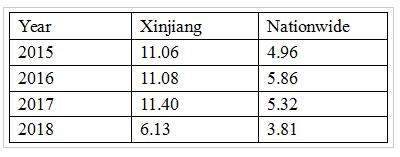
Lie No.2: "In 2018, natural population growth plummeted: to 4.06‰ in all minority regions and 2.58‰ in Kashgar and Hotan."(Quoted from Adrian Zenz's report.)
This is not true. According to statistics released by Statistical Bureau of Xinjiang Uygur Autonomous Region, the natural population growth rate of the whole region in 2018 is 6.13‰. Among the four prefectures in south Xinjiang with a majority of ethnic minorities, the growth rate in Kizilsu Kirghiz Autonomous Prefecture is 11.45‰, Kashgar 6.93 ‰, Aksu 5.67‰, and Hotan 2.96‰. With the exception of Hotan, the natural population growth rates in Kizilsu, Kashgar and Aksu in 2018 were all higher than the figure of 4.06‰ mentioned in Adrian Zenz's report. Besides, the natural population growth rates in Kashgar (6.93‰) and Hotan (2.96‰) are also different from the figure of 2.58‰ falsely stated in the report. It is clear that being vague about data sources and lacking authenticity have become a unique writing style of Adrian Zenz.
Table 2: Natural population growth rate nationwide and partially in 2018 Unit : ‰

Lie No.3: "Population growth rates in a Uygur region where Han constitute the majority were nearly 8 times higher than in the surrounding rural Uygur regions (in 2018)."(Quoted from Adrian Zenz's report.)
When mentioning the net population change rate for the Hans have increased to 7.42‰, Adrian Zenz used the word "estimate", which means it is an inaccurate assumption. Perhaps Adrian Zenz feels guilty about his lies, so he used vague terms to cover them up. As is known, Xinjiang is a multi-ethnic region where many ethnic groups reside in addition to the Hans and the Uygurs. The Uygur population in Xinjiang from2010 to 2018 did not decrease as Adrian Zenz said, but showed an upward trend.
According to statistics, from 2010 to 2018, the total population of Xinjiang at the end of the year rose from 21.8158 million to 24.8676 million, an increase of 3.0518 million or 13.99%. Specifically, the ethnic minority population rose from 12.9859 million to 15.8608 million, an increase of 2.8749 million, an increase of 22.14%; among them, the Uygur population rose from 10.1715 million to 12.7184 million, an increase of 2.5469 million, an increase of 25.04%. During the same period, the Han population rose from 8.8299 million in 2010 to 9.0068 million in 2018, an increase of 0.1769 million or 2.0%. In summary, the growth rate of the Uygur population inXinjiang is not only higher than that of the entire Xinjiang population, it is also higher than the growth rate of the minority population in Xinjiang, and it is significantly higher than the growth rate of the Han population in Xinjiang.
Lie No.4: "Net population change for Kashgar and Hotan was even lower, at 0.22‰ (and -0.25‰ for all minority counties). Meanwhile, increases in permanent resident populations boosted estimated net population change in Han majority counties to 7.42‰."(Quoted from Adrian Zenz's report.)
When debunking Lie No.3, we have expatiated the population data of Xinjiang's ethnic groups over the past 40 years, so I will not repeat it here. One thing to be sure of is that Adrian Zenz's statement of "increases in permanent resident populations boosted estimated net population change in Han majority counties to 7.42‰" is groundless, with neither fact nor data to support. Concerning the low net population growth rate mentioned by Adrian Zenz, according to the statistics released by the Statistical Bureau of Xinjiang Uygur Autonomous Region, the natural population growth rates of all cities and counties in south Xinjiang's four prefectures remained positive in 2018. According to the data in Table 3, it can be calculated that the average natural population growth rate of the 28 counties in the four prefectures in south Xinjiang is 4.80‰. To be specific, the average natural population growth rate of Kashgar's 11 counties is 5.53‰, Aksu's 7 counties 4.48 ‰, Hotan's 7 counties 2.94‰, Kizilsu's 3 counties 7.25‰.
According to the above analysis, neither based onthe average natural population growth rate of the 28 counties in south Xinjiang's four prefectures (4.80 ‰) nor on the average natural population growth rates of the counties under the four prefectures can we draw a conclusion that the net population growth rate is "-0.25‰ for all minority counties" as Adrian Zenz put it. His statement that "net population change for Kashgar and Hotan was even lower, at 0.22‰" is also inconsistent with the actual situation in Kashgar and Hotan. It is against the spirit of science that he uses false data to substantiate his report for the purpose of defaming China.
Table 3: Natural population growth rate in south Xinjiang in 2018 Unit: ‰
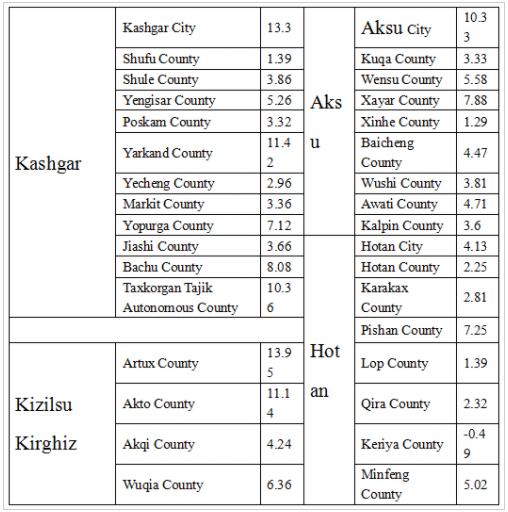
Lie No.5: "For 2020, one Uygur region set an unprecedented near-zero population growth target: a mere 1.05 per mille, compared to an already low 11.45 per mille in 2018."(Quoted from Adrian Zenz's report.)
Again, it turns out that Adrian Zenz tampered with the figures of relevant documents released by Kizilsu Kirghiz Autonomous Prefecture to complete his report. As can be seen in the budget report from the Health Commission of Kizilsu Kirghiz Autonomous Prefecture in Chart 2, under the first-level target "Completion target", the natural population growth rate of the second-level target "Quality" is set at 1.05%. It is worth noting here that the unit used in this document is per cent. In other words, when the unit is converted from per cent to per mille, the natural population growth rate should be 10.5‰. When debunking Lie No.2, we have mentioned the natural population growth rate of Kizilsu Kirghiz Autonomous Prefecture in 2018 is 11.45 ‰, which means the rate mentioned this document is reduced by only 0.95 per-millage. Therefore, Adrian Zenz's statement that the natural population growth rate is "a mere 1.05 per mille, compared to an already low 11.45 per mille in 2018" is actually a confusion of measurement unit so as to fabricate lies in his report.
Chart 1: Expenditure & performance target of Kizilsu Kirghiz Autonomous Prefecture
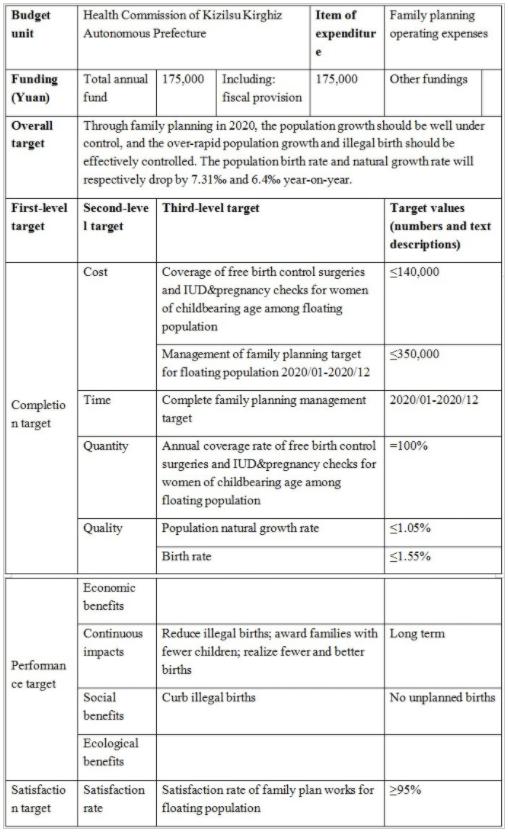
From the above "viewpoints" of Adrian Zenz, we can see that in order to make the lies in his report appear authentic, he has adopted such methods as arbitrarily tampering with data, confusing measurement units, using ambiguous concepts and being vague about sources, etc. Moreover, Adrian Zenz never indicated the name and source of the government documents he mentioned in his report, let alone basic introductions to the reliability and authenticity of the documents. In addition, there is no further elaboration of the relevant documents in the full text, making the sources of his so-called "systematic analysis of government documents" unreliable. We are even wondering whether the data sources were simply made up to support his arguments.
II. Present truth based on facts
Population is considered endogenous to economic growth, and is closely related to economic and social development. Population situation plays an important role in optimizing resource allocation, promoting trade circulation and enhancing economic vitality. The economic and social development of Xinjiang bears on the well-being of the people of all ethnic groups there, and the population situation of all ethnic groups is of great significance to the economic and social development of Xinjiang.
1. Analysis of Xinjiang's population situation based on population growth trend
According to the statistics, from the change trend of the total population at the end of the year in Xinjiang, the total population of Xinjiang at the end of 2010 was 21.8158 million, and the total population of Xinjiang at the end of 2018 was 24.8676 million. Compared with 2010, the total population of Xinjiang at the end of 2018 increased by 3.0518 million.Judging from the changing trend of the Uygur population in Xinjiang, the Uygur population in Xinjiang was 10.1715 million in 2010, and the Uygur population in Xinjiang was 12.7184 million in 2018. Compared with 2010, the Xinjiang Uygur population increased by 2.5469 million in 2018. Judging from the changing trend of the Han population in Xinjiang, the Han population in Xinjiang was 8.8299 million in 2010, and the Han population in Xinjiang was 9.0068 million in 2018. Compared with 2010, the Han population in Xinjiang increased by 0.1769 million in 2018. It can be seen that both the total population of Xinjiang at the end of the year, the Uygur population and the Han population are all on the rise.
Concerning the health development of all ethnic groups in Xinjiang, since the founding of the People's Republic of China in 1949, physical fitness of the ethnic populations in Xinjiang has been greatly improved thanks to the rapid development of the medical and health care system. According to the statistics released by the Statistical Bureau of Xinjiang Uygur Autonomous Region, the death rate in Xinjiang dropped from 20.82 ‰ in 1949 to 4.56 ‰ in 2018, a drop of 16.26‰. It demonstrates that the right to health of Xinjiang's ethnic populations has been effectively protected.
2. Analysis of Xinjiang's population situation based on population structure
According to the data released by the Statistical Bureau of Xinjiang Uygur Autonomous Region, over the 40 years from 1978 to 2018, the ratio of male to female in Xinjiang remained stable. As Table5 shows, from 1978 to 2017, the male population in Xinjiang remained slightly larger than the female population. In 2018, the female population in Xinjiang surpassed the male population for the first time in 40 years. According to the statistics, in 2018, there were 12.3983 million men in Xinjiang, accounting for 49.86% of the total population; the female population was 12.4693 million, accounting for 50.14%. However, looking at the gender composition in Xinjiang over the past 40 years, the proportion of male to female remained an overall balance. Therefore,we can say gender selection is almost non-existent in Xinjiang.
Table 4: Xinjiang's gender composition in main years from 1978-2008
Unit: million , %
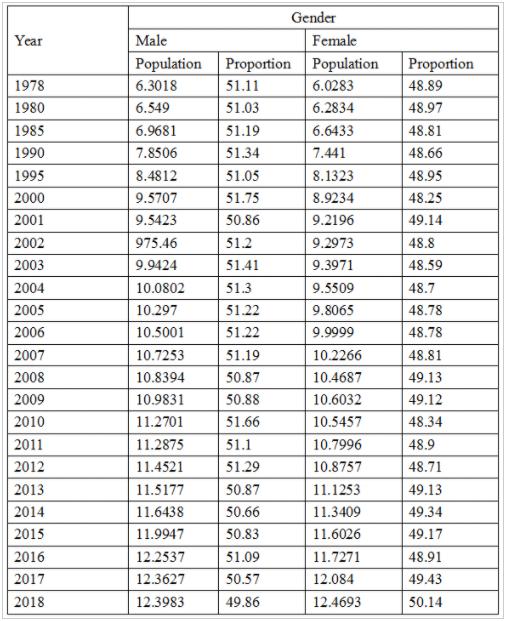
3. Analysis of Xinjiang's population situation based on educational levels
A thriving education makes a thriving country and a powerful education makes a powerful country. The situation of higher education is an important indicator of a country or region's development and potential. Presently, Xinjiang is in the golden period of development, and the need for science and talents becomes more urgent than ever. According to the Statistical Bureau of Xinjiang Uygur Autonomous Region, the number of students in Xinjiang's institutions of higher learning was 10,229 in 1978, and the figure rose to 398,751 in 2018. That is to say, from 1978 to 2018, the number of students in institutions of higher learning in Xinjiang increased by 388,522. From a diachronic perspective, as shown in Chart 3, the number of students in institutions of higher learning in Xinjiang has been increasing year by year since 1978. The number went straight upespeciallyafter2000.The data suggests that the right to education of people of all ethnic groups in Xinjiang has been effectively protected.
Chart 2: Number of students in Xinjiang's institutions of higher learning from 1978 -2018
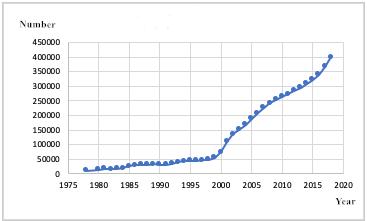
III. Conclusion
To respect and protect human rights is prescribed by the Constitution of China. At present, China's Xinjiang has made new progress in the cause of human rights. However, some western politicians and anti-China "scholars" are fabricating all kinds of lies relating to Xinjiang affairs and other Chinese affairs out of ideological bias or other ulterior purposes. No matter how the lies are beautified, they will always be debunked when faced with the truth. Through an analysis of the population data, this paper offers a clear presentation of Xinjiang's actual population situation. It is undoubtedly a powerful response to the western politicians and "scholars" smearing Xinjiang's human rights situation from the perspective of population.
As a product of historical conditions, human rights is bound to develop with the development of historical conditions. At present, Xinjiang is in the golden period of prosperity and development. The rapid economic development in Xinjiang has laid a solid material foundation to the cause of human rights in Xinjiang, and the harmonious and stable society have provided favorable social conditions. The positive momentum of Xinjiang's population situation is a strong proof that the human rights of people of all ethnicities in Xinjiang have been guaranteed and promoted all the time. The people of all ethnicities in Xinjiang have a common goal of pushing for continuous progress of human rights, and they will work together to strengthen the protection of human rights and promote the progress of human rights among people of all ethnic groups in Xinjiang.
